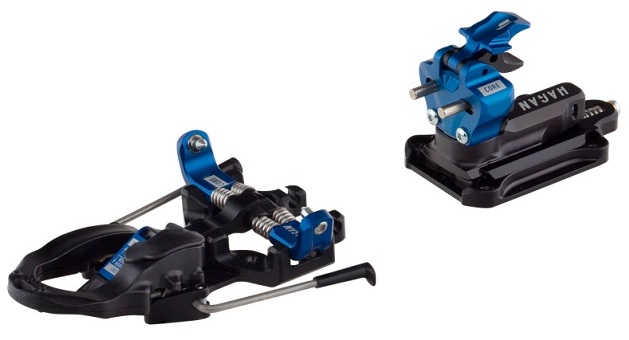
ATK Raider 2.0 12 / Hagan Core 12
Release Value Range: 5-12 (independently adjustable lateral and vertical release)
Available Brake Widths: 90, 105, 115 mm
Available Crampon Widths: 86, 91, 97, 102, 108, 120 mm
Climbing Aids: Flat, 38, 41, 48, 58 mm
Forward Elastic Travel: ~5 mm (though still mounted with a 4mm heel gap)
Mounting Pattern Width: 30 mm (toe), 45 mm (heel)
Heel Mounting Gap: 4 mm
BSL Adjustment: 30 mm
Stated Weight: 350 grams
Blister’s measured weight:
- Toe: 117.5 & 117.7 g (without brakes)
- Heel: 187.3 & 188.5 g
- Brake: 54.9 & 53.9 g
- Screws: 15.3 & 15.4 g
- Total: 375.0 & 376.5 g
MSRP: $625 USD
Boots Used: Scarpa Maestrale RS; Nordica Strider 120; Tecnica Zero G Tour Pro; Salomon S/Lab MTN
Ski Used: Salomon MTN Explore 95
Test Locations: Elk Mountains & Arapahoe Basin, CO
Days Tested: 7
[Note: Our review was conducted on the 18/19 ATK Raider 2.0 12 / Hagan Core 12, which was not changed for 19/20, apart from graphics.]
Intro
The 2nd installment of Blister’s Lightweight Touring Binding Shootout features the Italian Stallion, the ATK Raider 2.0 12 / Hagan Core 12.
This binding has developed a bit of a cult following over the past few years. Devotees praise its all-metal construction, full feature set, and impressively low weight. However, the binding can be difficult to come by here in the USA, with Hagan being the sole ATK distributor here.
(Hagan sells their branded version of the Raider 2.0 under the “Core” name — and it comes in a nice cerulean blue colorway, too. But both bindings are identical in construction and function.)
The Hagan Core 12 / ATK Raider 2.0 12 doesn’t come without its quirks, though. There are a few unique design elements that make it stand out from the other bindings in the test, in both positive and negative ways.
Design
Besides the obviously unique position of the brake on the toe piece, the design of the Raider 2.0 12 / Core 12 looks pretty familiar at first glance, but there are a few things that set it apart from the other bindings in our test.
Toe Piece
Sam Shaheen (5’10”, 140 lbs): We’ll talk about the Raider 2.0 12 / Core 12’s brake in a bit, but apart from that, their toe piece looks pretty standard in design. The thing that stands out the most about the toe is how solid and substantial it feels. The entire baseplate and lower frame is made from a single, beefy piece of aluminum, making this the simplest toe piece in the test (at least when used without the brake).
The toe of the ATK / Hagan is also the easiest to step into in our test. It doesn’t have any sort of visual aids or bumpers to aid with stepping in, it just works well. And the jaws of the Raider 2.0 12 / Core 12 open wider than the Marker Alpinist, which makes it easier to position the toe lug of the boot.
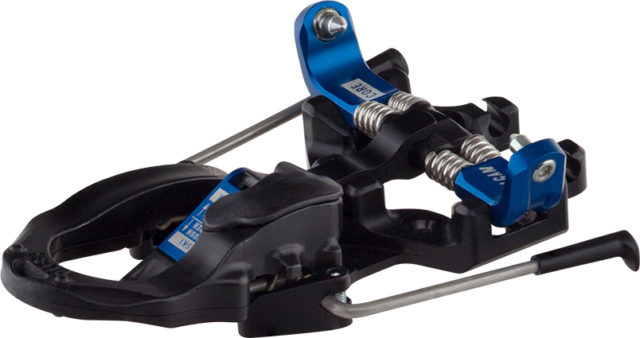
With a bit of downward pressure, the jaws of the Core 12’s toe piece snap shut with a very satisfying, confidence-inspiring “whack.” Similar to the Alpinist, I’ve rarely felt the need to lock out the toes. The one exception was when skiing the North Face of North Maroon Peak (D15, R3) in near bulletproof snow, where I’d probably want to lock out the toes on nearly any binding. Overall, the Raider 2.0 12 / Core 12’s toe retention feels excellent, and I felt more confident skiing hard downhill on it than on any other binding in this test.
Luke Koppa (5’8”, 155 lbs): I agree that this binding feels very solid and secure. There’s a lot of metal there, so I’m actually a bit surprised by how light it is.
I also found the Core 12 to be the easiest binding in our test when it came to stepping in. It’s quite intuitive, and I probably stepped in on my first try about 75-85% of the time.
The one area where my opinion differs from Sam’s is in regard to the confidence the Core 12 / Raider 2.0 12 inspires on the downhill. Personally, I prefer the damper / smoother feel of the Alpinist over the harsher feel of the Core 12, though they are both pretty powerful bindings for their weight.
Heel Piece
Sam: Similar to the toe, the heel of the Raider 2.0 12 / Core 12 is made entirely from metal, and feels extremely solid and well designed.
The Core 12’s heel piece is not a U-spring design, making it unique in our test. It features two independent pins that rotate during step-in to reduce wear on the heel insert of your boot. The Core 12 / Raider 2.0 12 is also the only binding in this test with independently adjustable vertical and lateral release values in the heel. The Alpinist and Dynafit TLT Speed have fixed vertical and adjustable lateral release while the Salomon/Atomic MTN/Backland has fixed release for both vertical and lateral release. All the other bindings use a U-spring design though, so their springs can be swapped to adjust vertical release.
One result of its independent pin design is that the Raider 2.0 12 is the easiest binding when it comes to stepping into the heel piece — something that can really come in handy on steep slopes or in deep pow.
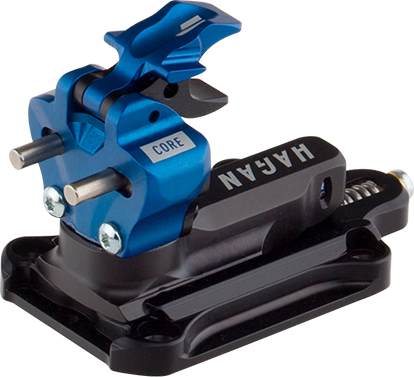
The heel risers of this binding are easily the best in the group. Not only do they offer 5 different climbing positions, but they are super easy to actuate with a pole basket and snap securely into place with magnets. This design is slick and surprisingly user-friendly.
Another unique thing about the Raider 2.0 12 / Core 12 heel piece is that it comes standard with a 30 mm adjustable heel track. This track offers plenty of room to accommodate different BSL’s (and makes testing for us a lot easier).
The Core 12 / Raider 2.0 12 is also the only binding in our test that is both mounted with a heel gap and offers an element of elastic travel. This provides good piece of mind, especially when skiing hard and bending your skis, since the chance of shearing off the heel tower of a binding with elastic travel is lower than on models with a fixed heel track. However, that heel gap is also likely responsible for its noticeably harsher ride compared to the Alpinist, which we’ll talk about further down.
Yet another differentiator of the Core 12 / Raider 2.0 12 heel piece is that ATK offers what they call a “Freeride Spacer” to fill the gap between the bottom of the sole on the heel of the boot and the ski. The idea behind this is to increase power transfer since, with the addition of the spacer, the heel of the boot would then be in direct contact with the ski, rather than only being in contact with the heel pins. Though we haven’t yet tested the binding with the Freeride Spacer, our curiosity is high, and we hope to be able to try it out next season.
The Raider 2.0 / Core 12 heel piece is not without its quirks. I’ve noticed that, while ski mountaineering in situations where I needed to take off my skis on steep slopes, the heel piece had a tendency to stick in the heel inserts of my boots, making it difficult to take the ski off. I think this is the result of the binding’s heel pins pinching the heel insert a bit and causing slightly more friction when trying to push the boot forward. This isn’t a huge deal, but it has been a little scary when it’s happened in very exposed situations.
Finally, it’s worth noting that the heel piece of the Raider 2.0 / Core 12 is adjusted with a #1 Phillips head screw driver, rather than a #2 Pozidrive like most other bindings on the market.
Brakes
Sam: The most obvious oddity of this binding is that the brake mechanism is attached at the toe rather than the heel. However, this doesn’t seem to make much of a functional difference — it just looks weird.
The Raider 2.0 / Core 12’s brake system is easy to use and actually simpler than the brakes on the Alpinist. Whether you are in uphill or downhill mode, the process of switching the Core 12’s brake is the same, and there is no risk of locking the brake up while in ski mode.
When you step into the toe, the brake remains down, and you must push the large plastic brake lever down with either a pole tip or your hand to lock it. A small metal stop on the toe piece holds it in place. The design is simple and, so far, has been quite effective.
Similar to the Alpinist brake, however, the Core 12’s brake doesn’t offer very much stopping power. I trust it to keep a ski in place while I’m stepping in on a flat surface, but I wouldn’t count on it to stop a runaway ski on a steep slope.
The Core 12’s brake is removable and can shave about 100 grams off the weight of the pair if removed. However, without the brake there are some extra parts left on the baseplate of the binding, and it is quite difficult to get the brakes back on once you’ve taken them off.
Uphill Performance / Transitions
Sam: The Raider 2.0 / Core 12 is not the lightest binding in our test, but it is the lightest one with brakes (by about 10 grams). All of the bindings in this test feel feathery light on the way up and the Core 12 is no exception.
Transitioning in the Core 12 is simple, but not the easiest on the market. To switch modes, you have to turn the heel tower with your hand — there is no easy way to turn the tower with a pole tip. The Core 12 heel piece is also one of the more difficult to spin because of its shape. It’s just difficult to get a good grip on it. But compared to bindings like the Dynafit Radical 2.0, the Core 12 is still easier, and you don’t have to deal with a brake while transitioning the heel.
If you don’t want to spin the heel tower of the Core 12, you can just flip down the first heel riser and start touring (though if you want the flat touring option you’ll still have to rotate the heel).
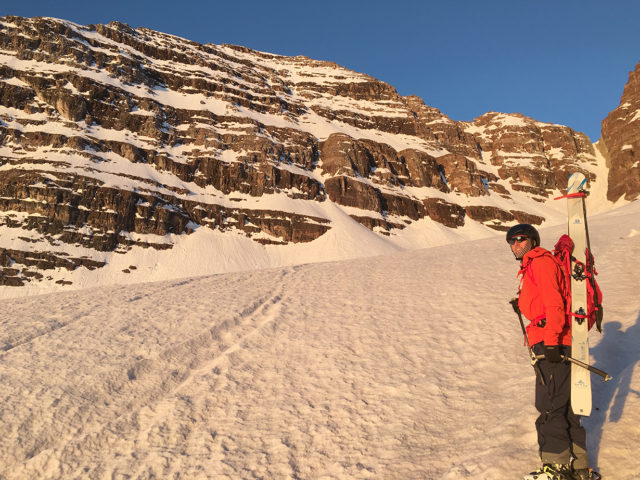
I usually still find myself rotating the heel piece when on the up. It allows me access to flat touring mode (which, in Colorado, I use all the time) as well as two other riser heights that can get me up mellow and steeper skin tracks just fine. If I’m doing quick laps though, sometimes I’ll forgo rotating the heel and just flip the riser down over the pins to speed things up.
Like all of the bindings in this test, with lightweight heel pieces, you get a more forward balancing point on the ski which can cause your ski tips to dip on kick turns rather than pop up like on bindings with heavier heel pieces. A bit stronger “kick” in your kick turn should take care of this.
Luke: One thing I want to emphasize is this binding’s versatility when it comes to riser heights. While the Alpinist lacks any very high risers, the Core 12 has 5 different touring height options. So if you really want to get your riser height just right, the Raider 2.0 / Core 12 gives you the most options.
Downhill Performance
We’re going to be making this caveat in all of the downhill performance sections for the bindings in this test. Two things really stood out to us while testing these bindings:
First, the downhill performance of each binding is surprisingly similar. If we weren’t skiing them back-to-back, I doubt we would be able to discern many differences in performance.
Second (and perhaps even more surprising), is how hard we were able to ski on these bindings without pre-releasing or breaking anything — including ourselves.
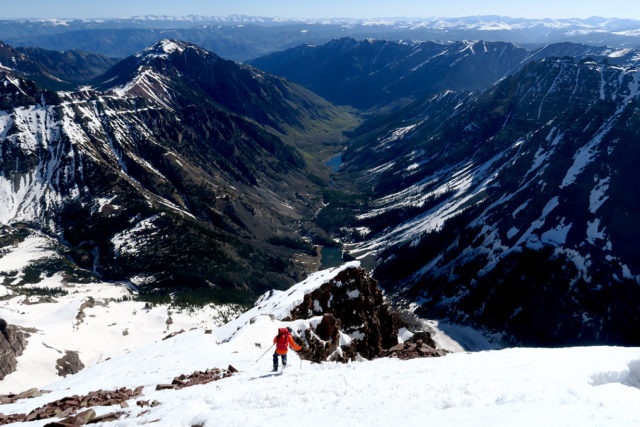
Much of our downhill-performance testing was done inbounds on firm or soft, chopped-up snow and at very high speeds. All of the bindings in the test performed surprisingly well (though the real standout in our Shootout was easily the ski — the Salomon MTN Explore 95 that we had all the bindings mounted on is just soooo good).
That being said, we were able to conclude a few things about the Raider 2.0 / Core 12’s downhill performance. It is worth noting that we did not test this binding with the Freeride Spacer, and we suspect most of its downhill performance aspects would improve with this feature, especially power transfer.
Sam: The Raider 2.0 12 / Core 12 is probably my favorite overall binding in the test. From a downhill perspective, it has a pretty traditional tech binding feel. It transfers a lot of energy / feel from the snow into the boot — the Core 12 is one of the most harsh bindings in the test. But with that harshness comes precision. Yes, the vibrational feedback from the snow can be jarring and tiring. But I find that when skiing in the backcountry, I hardly ever ski enough downhill to make my downhill muscles too tired because my uphill muscles are shot long before the downhill ones. So while I certainly prefer the smoother ride of the Alpinist in terms of pure downhill performance, I can definitely deal with the harsher feel of the Raider 2.0 12 / Core 12 on the down.
The Core 12 also lands in the top half of the group when it comes to power transfer — only the Alpinist is better in this category. The Core 12’s all-metal construction contributes to a very solid-feeling binding that feels like it has a good connection to the ski.
As I mentioned in the Alpinist review, one surprising thing I noticed between these bindings was the amount of rebound and energy from the ski that each binding transferred to my boots / body. In this sort of nebulous “Energy” measure, the Core 12 tops the group. I.e., the MTN Explore 95 felt the most poppy and energetic on my feet when it was mounted with the Core 12.
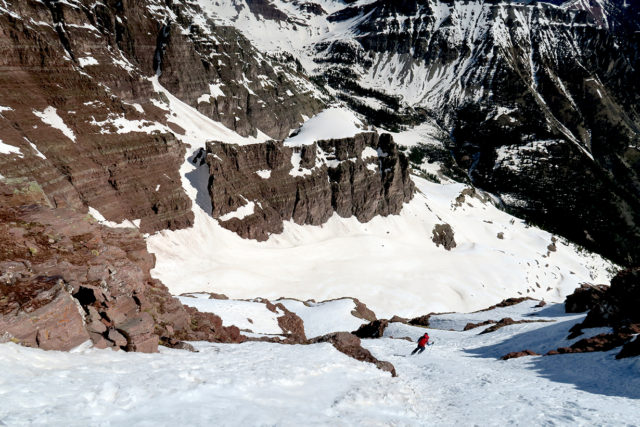
Luke: Due to its strong power transfer and solid construction, the Raider 2.0 12 / Core 12 was my second-favorite downhill binding in this test. As I noted earlier, I personally prefer the smoother feel of the Alpinist, but the Raider 2.0 12 / Core 12 does provide a slightly more powerful ride compared to the TLT Speed and MTN / Backland Tour.
I have a hunch that the addition of the freeride spacer would probably close the gap a bit between the downhill performance of the Core 12 and the Alpinist, so I’m eager to try that out next season.
Safety / Release
Sam: We have yet to experience a pre-release on the Core 12 and, because of the non U-spring heel and independently adjustable vertical and lateral release values, the Core 12 is likely the safest binding in our test. Without getting each binding on a testing rig and running side-by-side experiments, it’s difficult to say for certain which binding is objectively safer. But if I had to pick a binding that I would trust to hold in my boot when needed, and to release when it should, the Core 12 would definitely be my first choice.
Durability
Sam: We haven’t experienced any out-of-the-ordinary wear on our pair of Core 12 bindings, and we’ll update this review next season if that changes. But as I’ve repeatedly said, this binding feels very solid and I would be surprised if we experience any unusual failures.
Who’s It For?
Sam: This binding isn’t the very best in the test in a number of specific categories, but its overall performance makes it my favorite binding of the group. Its construction is solid, its downhill performance is excellent for its weight, and it is easy to operate in the backcountry.
Skiers looking for a simple, well-engineered, fully-featured binding (and who are willing to pay a little more) should definitely consider the ATK Raider 2.0 / Hagan Core 12. It isn’t the smoothest downhill performer in our test though, so if that’s a priority for you, the Marker Alpinist is probably a better bet.
Luke: Yep, I think Sam summarized that well. The Core 12 is a very good all-around binding, and I think anyone looking for a durable, simple, effective, and lightweight touring binding that still skis quite well for its weight will appreciate the Raider 2.0 12 / Core 12. It does still have that fairly harsh downhill feedback that so many lightweight pin bindings have, but I still wouldn’t mind using the Core 12 for skiing fairly hard on wider skis.
Bottom Line
The Hagan Core 12 / ATK Raider 2.0 12 is a well-built, well-thought-out touring binding. It is the most fully-featured binding in our test, without being the heaviest binding in our test. The Core 12 is easy to use on the uphill and can be pushed hard on the way down. It’s a bit more expensive than some of the other bindings, but if you’re willing to spend a little more, we think the Raider 2.0 12 / Core 12 is an excellent option for lightweight ski touring and mountaineering.

How do you feel about the forward ramp? Have you tried it with the toe riser plate?
Hey sf, no, we didn’t use the toe riser plate. I also didn’t notice the increased ramp angle. I used to be very sensitive to things like forward lean and ramp angle but the more and more different gear I get on, the less and less I notice it.
If we had this binding mounted on a more freestyle oriented, playful ski, then I probably would have noticed the stance difference, but the MTN Explore 95 is a very directional ski that lends itself more to skiing steep lines than jumping off stuff. For that kind of skiing, the ramp angle isn’t a big deal for me.
Hi Sam,
Have you tried or planned to try the ATK raider 2.0 14? I’ve a got these bindings on a pair of Black Crows Anima freebird, the raider 14 have a wider platform than the 12, with 8 holes for the toe piece, and the freeride spacer under the heel, the power transfer is, in my opinion, very good. I would be interested to know your opinion about that point to compare with the Marker alpinist 12. The ATK is around 600€/700$, so, if the alpinist 12, is close to the raider 14, in term of power transfer, with a smooth ride and almost the same weight, I would opt for these…..(40% cheaper)…..next season to Mount on my new pair of Voile V8.
Thank you.
Hey BB,
The 14 certainly looks like a more burly binding than the 12. The reinforced toe piece should definitely contribute to more durability (though I’m not sure the hole pattern would work with the MTN Explore 95’s mounting zones). The Raider 2.0 14 will be heavier than the Alpinist — especially if you mount the Alpinist sans brakes. We are looking forward to getting time in the ATK with the Freeride Spacer, and we’ll update this review when we do.
Sam
The Freeride spacer makes a noticable difference. I added it to my Ion LT and the difference in feel was immediate. The ski (17/18 Black Crows Camox Freebird) felt more responsive, powerful, and solid, it also helped with vibration damping as less “noise” was transmitted up through the ski into leg which left for a much less fatiguing ride. I would highly recommend adding it to any setup. And at 30g per ski the weight is utterly negligible.
I did lose a bit on the “flat mode” on the uphill but even that if I hadn’t have walked hundreds of miles on that flat mode already, I probably wouldn’t have noticed the difference as much and I don’t feel like my stride or angle is compromised or detracted from it is just a different feel.
I think that the ATK freeride spacer is a different beast than the ones for G3 bindings. IIRC (though it’s been a while since I looked and I may be misremembering) the G3 spacers are simple blocks of plastic, so you have to be careful about putting too much heel pressure on them lest the boot heel bind as tjaard described in another post.
The ATK spacers are sliding AFDs, wherein the plastic surface in contact with the boot sole moves from side to side and allows the boot heel to release freely. I feel a lot more comfortable adjusting an AFD like that right up to a grippy rubber boot sole (which is what ATK recommends) than I would with any non-sliding pad.
At the risk of setting off a flamewar, I also think that ATK’s heel tower is more solid than some out there, which means that the spacer is truly optional. I don’t think they would have an issue like the well-known one with the Zed where you *have* to put something in there to avoid blowing up the heel tower.
After using ATK Raider 12 for two seasons I switched to Salomon MTN. Much better binding in almost all aspects. So I am quite curious how you liked it.
Cant find much on the original atk raider, anyone have input on it?
Matus,
If you’ve skied the ATK Raider 12 for two seasons, that means you haven’t been skiing the Raider 12 2.0. It only came out a year ago. It and the Hagan Core 12 are significantly improved.
The Freeraider 14 is in my opinion the best tech binding out at the moment. It’s insane to me that this binding isn’t being promoted in the North America freeride scene. I’ve had two pairs that I’ve used for the last two years and they work flawlessly. I’m skiing them on Black Crows 184 Atris and 178 Camox Freebird. Also, the binding is way cheaper to order from Europe and have sent to the states. Its tax free import for under $800. They sell for around $530 with shipping online. I’m not sure how or why they want almost $700 from Hagan.
Any update on tests with the freeride spacer?
Hi!
have you tried the new R12 or FR14? I am preparing a free rando set, so i can use it in powder days in the resort but also skin up, so I really value downhill performance and decent weight. I can ski pretty fast and on steep terrain, but I won’t do any cliff jumping – so I’m not a hardcore freerider!
If these cut 300gr versus the dynafit rotation and have similar performance, i would go for them. would you recomend R12 or FR14?
is it worth the freerider spacer?
thanks!
Here is a test of the R12:
https://www.alpin.de/
Note that they measured up to 23% too high release torque. Other than that, it got mostly great marks.
Looking at the freeride spacer, I would worry that this would compromise release. The Alpin test saw this effect with the Salomon/Atomic binding, when using the brake, no matter how low a spring they used, it wouldn’t release at a reasonable torque.
Similarly, Jeff Campbell’s research showed problems with AT boots’ rubber sole not releasing properly from regular alpine bindings’ toe pieces, because the sole catches and hangs up AFD.
I use the spacer with Raider 12s.
The key thing that you seem to be missing here is that the spacer contains a sliding-type AFD, such the top of the spacer slides from side to side along an internal bearing surface. This means that there is no impact to release performance if the boot sole “catches and hangs up” on the spacer as you describe (and that’s exactly why alpine bindings designed for the newer rubber-soled boots also use sliding AFDs). I don’t see any subjective difference in release performance when hand-releasing my setup with/without the spacer on the bench.
For me (>200 lbs, ex-racer) the spacer is worth it. I can feel better heel stability/transmission with the spacer in, and it makes me mess nervous about the loads carried by those pins.
Silly question: Is the spacer even compatible with the R12? The difference between the Raider 12 and R12 is that the brake is relocated from the front of the toepiece to a conventional location at the front of the heelpiece, i.e. exactly where the spacer goes.
One other remark: If you’re comfortable mounting your own bindings and can afford the investment, ATK’s jig is as much of a work of machined art as the bindings (Hagan sells it online).
The “older” versions of the ATK Raider Series (Raider 12 2.0 and Freeraider 14 2.0) with the stopper/brake in front are compatible with a freeride spacer (AL05).
The “newer” releases of ATK the R12 and FR14 with stopper/brake back at the heel piece are compatible with a different freeride spacer (AL09) cause of relocated brakes.
The Freeraider 14 2.0 and FR 14 are sold with the specific freeride spacer. For the Raider 12 2.0 and R12 you have to buy them as an option.
I am the Hagan U.S. distributor. The new Hagan Core 12 Pro will be available this fall: https://www.haganskimountaineering.com/
It is made for us by ATK and is the same as the R12. The new, wider toe-piece means the Core 12 Pro/R12 is identical to the R14 other than the release value and lack of Freeride spacers, which are available as an option:
https://www.haganskimountaineering.com/
In other words, add the Freeride spacer to the Core 12 Pro and the only difference is the Freeride Spacer.